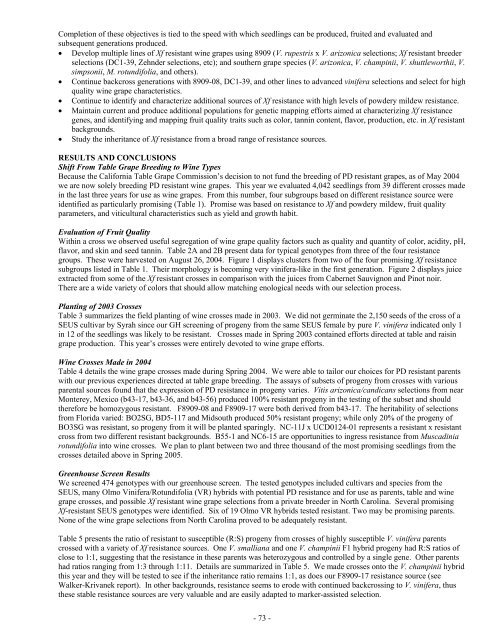Impact Of Host Plant Xylem Fluid On Xylella Fastidiosa Multiplication ...
Impact Of Host Plant Xylem Fluid On Xylella Fastidiosa Multiplication ...
Impact Of Host Plant Xylem Fluid On Xylella Fastidiosa Multiplication ...
Create successful ePaper yourself
Turn your PDF publications into a flip-book with our unique Google optimized e-Paper software.
Completion of these objectives is tied to the speed with which seedlings can be produced, fruited and evaluated and<br />
subsequent generations produced.<br />
• Develop multiple lines of Xf resistant wine grapes using 8909 (V. rupestris x V. arizonica selections; Xf resistant breeder<br />
selections (DC1-39, Zehnder selections, etc); and southern grape species (V. arizonica, V. champinii, V. shuttleworthii, V.<br />
simpsonii, M. rotundifolia, and others).<br />
• Continue backcross generations with 8909-08, DC1-39, and other lines to advanced vinifera selections and select for high<br />
quality wine grape characteristics.<br />
• Continue to identify and characterize additional sources of Xf resistance with high levels of powdery mildew resistance.<br />
• Maintain current and produce additional populations for genetic mapping efforts aimed at characterizing Xf resistance<br />
genes, and identifying and mapping fruit quality traits such as color, tannin content, flavor, production, etc. in Xf resistant<br />
backgrounds.<br />
• Study the inheritance of Xf resistance from a broad range of resistance sources.<br />
RESULTS AND CONCLUSIONS<br />
Shift From Table Grape Breeding to Wine Types<br />
Because the California Table Grape Commission’s decision to not fund the breeding of PD resistant grapes, as of May 2004<br />
we are now solely breeding PD resistant wine grapes. This year we evaluated 4,042 seedlings from 39 different crosses made<br />
in the last three years for use as wine grapes. From this number, four subgroups based on different resistance source were<br />
identified as particularly promising (Table 1). Promise was based on resistance to Xf and powdery mildew, fruit quality<br />
parameters, and viticultural characteristics such as yield and growth habit.<br />
Evaluation of Fruit Quality<br />
Within a cross we observed useful segregation of wine grape quality factors such as quality and quantity of color, acidity, pH,<br />
flavor, and skin and seed tannin. Table 2A and 2B present data for typical genotypes from three of the four resistance<br />
groups. These were harvested on August 26, 2004. Figure 1 displays clusters from two of the four promising Xf resistance<br />
subgroups listed in Table 1. Their morphology is becoming very vinifera-like in the first generation. Figure 2 displays juice<br />
extracted from some of the Xf resistant crosses in comparison with the juices from Cabernet Sauvignon and Pinot noir.<br />
There are a wide variety of colors that should allow matching enological needs with our selection process.<br />
<strong>Plant</strong>ing of 2003 Crosses<br />
Table 3 summarizes the field planting of wine crosses made in 2003. We did not germinate the 2,150 seeds of the cross of a<br />
SEUS cultivar by Syrah since our GH screening of progeny from the same SEUS female by pure V. vinifera indicated only 1<br />
in 12 of the seedlings was likely to be resistant. Crosses made in Spring 2003 contained efforts directed at table and raisin<br />
grape production. This year’s crosses were entirely devoted to wine grape efforts.<br />
Wine Crosses Made in 2004<br />
Table 4 details the wine grape crosses made during Spring 2004. We were able to tailor our choices for PD resistant parents<br />
with our previous experiences directed at table grape breeding. The assays of subsets of progeny from crosses with various<br />
parental sources found that the expression of PD resistance in progeny varies. Vitis arizonica/candicans selections from near<br />
Monterey, Mexico (b43-17, b43-36, and b43-56) produced 100% resistant progeny in the testing of the subset and should<br />
therefore be homozygous resistant. F8909-08 and F8909-17 were both derived from b43-17. The heritability of selections<br />
from Florida varied: BO2SG, BD5-117 and Midsouth produced 50% resistant progeny; while only 20% of the progeny of<br />
BO3SG was resistant, so progeny from it will be planted sparingly. NC-11J x UCD0124-01 represents a resistant x resistant<br />
cross from two different resistant backgrounds. B55-1 and NC6-15 are opportunities to ingress resistance from Muscadinia<br />
rotundifolia into wine crosses. We plan to plant between two and three thousand of the most promising seedlings from the<br />
crosses detailed above in Spring 2005.<br />
Greenhouse Screen Results<br />
We screened 474 genotypes with our greenhouse screen. The tested genotypes included cultivars and species from the<br />
SEUS, many Olmo Vinifera/Rotundifolia (VR) hybrids with potential PD resistance and for use as parents, table and wine<br />
grape crosses, and possible Xf resistant wine grape selections from a private breeder in North Carolina. Several promising<br />
Xf-resistant SEUS genotypes were identified. Six of 19 Olmo VR hybrids tested resistant. Two may be promising parents.<br />
None of the wine grape selections from North Carolina proved to be adequately resistant.<br />
Table 5 presents the ratio of resistant to susceptible (R:S) progeny from crosses of highly susceptible V. vinifera parents<br />
crossed with a variety of Xf resistance sources. <strong>On</strong>e V. smalliana and one V. champinii F1 hybrid progeny had R:S ratios of<br />
close to 1:1, suggesting that the resistance in these parents was heterozygous and controlled by a single gene. Other parents<br />
had ratios ranging from 1:3 through 1:11. Details are summarized in Table 5. We made crosses onto the V. champinii hybrid<br />
this year and they will be tested to see if the inheritance ratio remains 1:1, as does our F8909-17 resistance source (see<br />
Walker-Krivanek report). In other backgrounds, resistance seems to erode with continued backcrossing to V. vinifera, thus<br />
these stable resistance sources are very valuable and are easily adapted to marker-assisted selection.<br />
- 73 -











